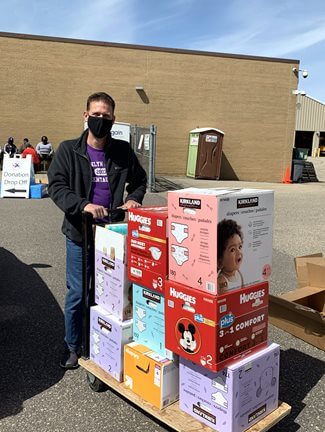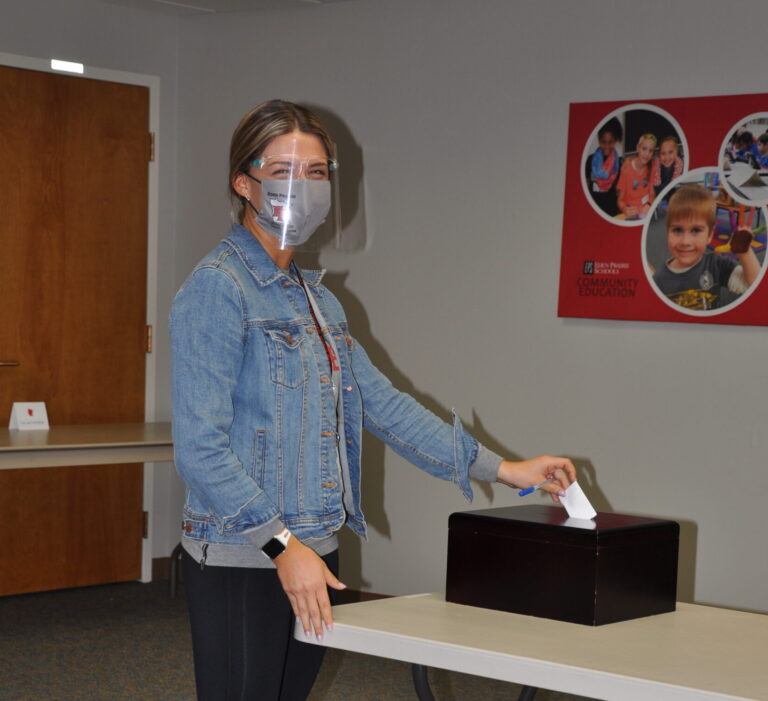
Brooklyn Center educators helped distribute food and supplies in the wake of the fatal police shooting of Daunte Wright.
The fatal police shooting of Daunte Wright in April not only shook the community of Brooklyn Center, but affected the high school building itself. Sitting across from the police department, the school became the hub for community support, while in the center of calls for racial equity.
“Given where our families live and where the incident happened, the first thought is what does this mean for our students and their safety?” said Ramon Martinez, an English language teacher at Brooklyn Center Middle and High School and Education Minnesota-Brooklyn Center vice president. “From a school perspective too, given that we work with so many community partners, it was a natural fit to call on those organizations to say, our families are going to be in need. There are things that they aren’t going to get because things are shut down and services were limited.”
Brooklyn Center Schools are full-service community schools, so the switch from education space to donation center was quick and comprehensive.
A full-service community school focuses on partnerships between a school and its community.
In Brooklyn Center, the district has partnerships between the schools and community organizations to provide educational, enrichment and support services to students and families. This includes medical facilities on site, so kids don’t have to miss school for a whole day for an appointment, and services that allow parents to find resources their families need.
“We already had community school leaders who were already working with those community partners and who were working with people who already had access to food and supplies,” said Sizi Goyah, math teacher at Brooklyn Center Middle and High School. “And we allowed those partners to lead us into more partners.”
The shooting happened on a Sunday, and by Monday, the partners were already working with the school, talking about how to use the site. The pieces were in place for the schools to become community donation intake and distribution sites.
“We recognized that there was going to be a huge need for food and supplies in our community. There has always been a food desert, but when Walmart and some of the stores closed, we knew there would be more of a need,” said Goyah. “The school was able to work with community activists and community partners to transition our Blue Barn, which is traditionally used for adaptive phy ed, as a collection space.”
“We saw how quickly the organization could be put together,” said Martinez. “Not only putting the word out that this is what the needs are, but putting the structure in place behind it, so that there wasn’t a delay in services to our families and those resources became available as quickly as possible.”
The district moved to distance learning for a few days, which allowed the physical spaces to be utilized. But as students and staff returned, the opportunity for hands-on learning and support took shape.
Numerous staff volunteered in the donation and distribution spaces on their prep and lunch time.
“Our top priority is always being with students. For some people, when something like this happens, you feel so powerless and when you can take action and do something, it helps with those feelings,” said Rhonda Johnson Marn, an English teacher and president of Education Minnesota-Brooklyn Center.
Students also wanted the opportunity to volunteer and help.
“We saw civics and math in action,” said Goyah. “Students helped sort and pack and load vehicles. They had an action learning in what it means to be a human, learning social justice which is social studies, being a part of history. We also were doing math, by fulfilling orders and calculating what was going to run out.”
Educators were sorting, making runs on their lunch breaks to go buy what was out to replenish the supplies and putting in their own money to buy supplies.
“Had we not had educators who were in the community school model and mindset for what it means to be a part of the community, that might have been difficult,” said Goyah.
Not only did Brooklyn Center educators step up, but so did others. The Osseo and Anoka districts reached out and provided donations and support. The district’s GoFundMe started with a goal of $1,000 but raised more than $140,000. Educators from all over Minnesota contributed, as well as other union members. Free food distributions were organized by other labor unions, like SEIU and the UFCW, as well as the Minneapolis Regional Labor Federation.
“Thank you to all of the educators in Minnesota,” Sizi. “We saw you sharing our flyer and sending money and volunteering. This is how a union is supposed to work and what union members do. This is the power of our union.”
Now the focus turns back to the students and getting them to the end of the school year.
“We hope they will have as much of a normal ending as possible,” said Johnson Marn. “Having some kind of stability at the end of the year will be important.”
“We want to end as a school community, coming back into the building,” said Martinez. “I know I needed that and the students and families needed that too.”
While Brooklyn Center educators hope that no other community will face a tragedy like theirs did, they do hope that people will realize how important full-service community schools are no matter what is happening in your area.
“There’s so much a student needs to be successful as a scholar,” said Johnson Marn. “ What the community school does is it pushes down the barriers that you might face when trying to engage a student. We talk about how it takes a village to care for a child. And a community school helps you address the needs of the whole child, and everything fits into the school day.”
“This symbolizes what education is supposed to be. School is not just an 8 to 4 in a brick and mortar building,” said Goyah. “School is about community. Whatever happens in the community enters the school.”





